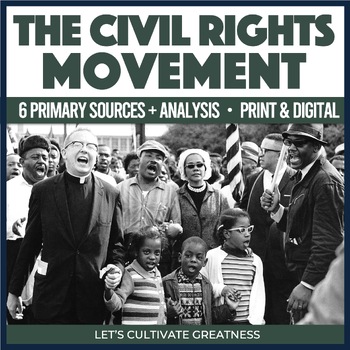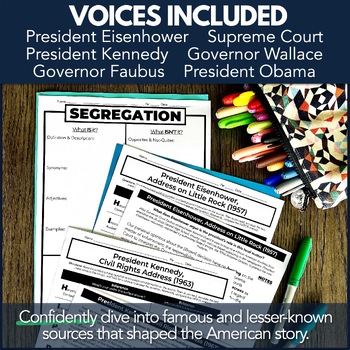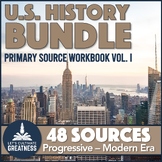Civil Rights Movement Primary Sources Activity Analysis Worksheets 6-Pack
- Zip
- Google Apps™

Also included in
- Strengthen your on-level U.S. History or AP US History units with 48 1-page-or-less, high-interest primary sources from 1900s modern American History:Turn of the Century - Progressive Era, Roaring 1920sHard Times - Great Depression, WWIIMid-Century - Cold War, Civil Rights MovementLate 1900s - VietnPrice $27.50Original Price $36.00Save $8.50
Description
Guide your students through Brown v. Board, Little Rock Nine, desegregation, the Civil Right Act of 1964, and the Selma March with a focused analysis of up to 6 different Civil Rights Movement primary source documents covering using the effective HIPPOS method!
This resource comes in Google Slide format for a paperless option!
Featured voices in this fight for equality:
- President Eisenhower
- Supreme Court
- President Kennedy
- Governor Wallace
- Governor Faubus
- President Obama
The effective HIPPOS framework directly targets Common Core critical thinking skills:
- Historical Context
- Intended Audience
- Point of View
- Purpose
- Outside Information
- So, what?
************************************
Greatness is sticking with what is right in one’s heart regardless of the resistance faced.
The Civil Rights Movement finally finished the work set forth a century earlier by demanding the federal government enforce and strengthen our nation’s laws and also its moral character. Arguments by leaders and supporters expanded beyond the legal realm and took a moral, patriotic, and rational position that proved successful.
Cut through the boring textbook and head straight to the compelling sources that make this era one of great activism, brave leadership, and the commitment to “holding these truths” up high for all to see, challenging your students to dare to dream, “How might I lead my generation’s cause?”
Included in this kit are:
- Detailed lesson plans, with strategies for different reading levels
- 1-page definition sheet for the concept “racism”
- 1-page HIPPOS handout and BONUS skill sheet, Annotating a Text
- 6 2-page student worksheets with a short primary source document & graphic organizer sheet
- Answer keys, one for each document
- EDITABLE Word Doc with all 6 sources and a generic graphic organizer sheet included to tailor to your classroom needs
- Google Slides version of all student sheets
Teaching Tips
- If used in-class, plan for up to 60 minutes to deeply introduce, read, annotate, analyze, and discuss each document.
- These documents also can be easily assigned as part of a jigsaw or gallery walk activity, as homework, or to keep on hand for emergency sub plans!
- Depending on the included scaffolds you use, these documents can be accessed by a wide range of reading levels
************************************
Want more Civil Rights Movement?
PBL Project: Montgomery Bus Boycott Activity 9-Pack: dig past the known story and discover what really starts a movement.
PBL Project: Little Rock Nine Activity 7-Pack: discover how fear influences human decision making in the balance of rights versus responsibility by getting into the heads of key people involved in this front-page crisis.
************************************
Bundle and save!
1600s - 1800s 48-Pack Bundle: get 8 HIPPOS Packs, from Colonial Era to Gilded Age
1900s 48-Pack Bundle: get 8 HIPPOS Packs, from Progressive Era to Modern Era
Or mix and match
Colonial America: analyze the rough start of the English colonists, the enslaved Africans, and the invaded Indians.
Early Nationhood: juxtapose the declared values of democracy with the arguments of its outsiders.
Era of Reform: hear the impassioned voices for change.
Westward Expansion: explore the mania and the mayhem created out West.
The Civil War: contrast the two very different defenses for freedom.
Reconstruction: evaluate the successes of national policy on the individual in post-Civil War America.
Gilded Age Diversity: compare the common dreams of a developing melting pot.
Gilded Age Labor: hear the voices of those who felt unheard in this age of wealth.
Progressive Era: learn how enough passion can turn anyone into an agent of change.
Roaring 1920s: sense the growing divide between rural, traditional and urban, modern American societies.
Great Depression: explore the changing relationship between president and citizen.
WWII Warfront: explore the difficult decision made by political and military leaders in the fight of their lives.
Cold War: examine the word choices of leaders fighting a war of words.
Vietnam War: weigh the role public opinion should play in complex foreign policy.
Modern Presidents: hear how our leaders struggle to unite the country.
************************************
This listing is for one license for regular, non-commercial classroom use by a single teacher only. Commercial use like online teaching (ex. Outschool) or sharing with other teachers (ex. shared drive, in a Facebook group, in a professional development training) is strictly prohibited.
By purchasing a license to this resource, you have access to all future updates at no cost, available under “My Purchases." Multiple and transferable licenses are available for purchase. PDF files are uneditable, other files have editing abilities, unless otherwise stated. All files are protected under federal copyright laws.
To request a complete terms of use prior to purchase or if you have any questions about this resource, please leave a question below under Product Q&A.






